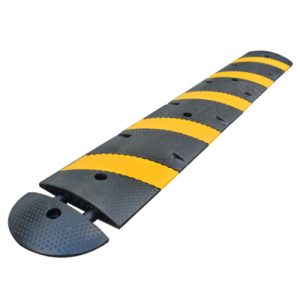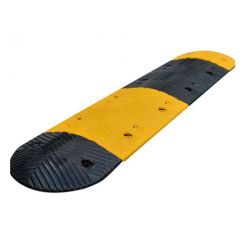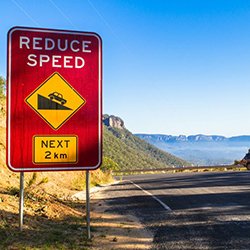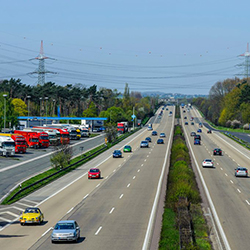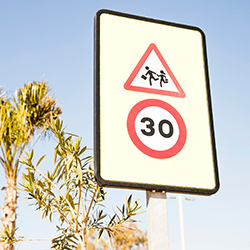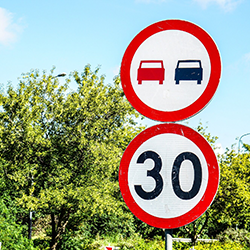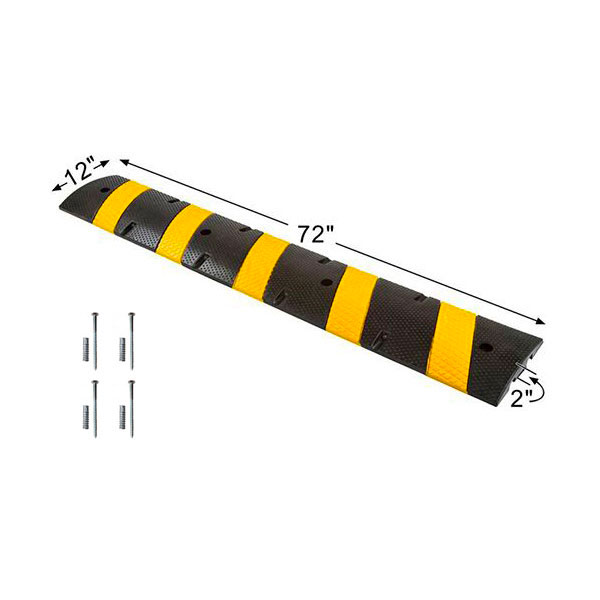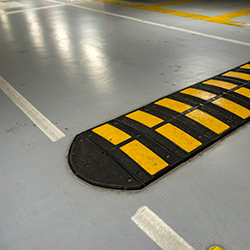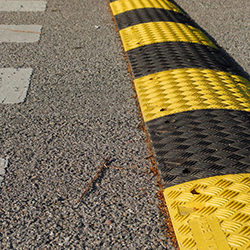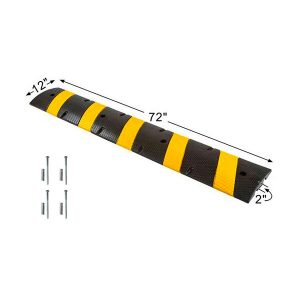
Are you looking to install speed bumps on your property? With so many regulations and legal requirements to consider, it’s hard to know where to begin. In this article, we’ll provide an overview of the regulations surrounding speed bump installation, including local and state laws, standards, and best practices. We’ll also explain what types of speed bumps are available, and provide tips to ensure compliance and avoid potential legal issues. By the end of this article, you’ll have the knowledge necessary to navigate speed bump regulations.
Speed Bump Purpose
Speed bumps are an effective traffic calming measure that improves road safety and reduces vehicle speeds. Speed bumps alert drivers to slow down before entering a certain area and help with traffic flow. They can be used in residential, commercial, and industrial areas to control speeding and ensure traffic safety.
The purpose of a speed bump is to reduce vehicle speeds on the roads and provide effective traffic calming. Speed bumps provide awareness to drivers and help reduce incidents of speeding. They also help reduce noise and air pollution levels by allowing vehicles to travel at lower speeds.
Speed bumps are most effective when strategically placed on roads that receive heavy amounts of traffic. When placed correctly, speed bumps can be an effective deterrent and can reduce vehicle speeds to an acceptable level. They should be placed in areas that have a history of speeding and accident problems.
In order to be effective, speed bumps must also be properly constructed and maintained. Typically, speed bumps are constructed with asphalt and should be at least 4 inches wide and 1–2 inches in height. The width of the speed bump should not exceed 4 feet and should be designed with a rounded crest in order to prevent damage to vehicles.
It is important to note that speed bumps should not be used as a substitute for traditional traffic calming measures such as speed limits signs and traffic signals. Instead, speed bumps should be used as a supplement to other traffic calming measures.
Speed bumps can be an effective traffic calming measure and can be useful in reducing vehicle speeds and improving safety on roads. By strategically placing speed bumps, drivers can be alerted to slow down before entering certain areas and help with traffic flow. Proper construction and maintenance of speed bumps is also important to ensure that they are effective.
Types of Speed Bumps
Speed cushions are an innovative solution for controlling and reducing traffic speeds. Speed cushions are raised rubberized platforms that are installed into the roadway. Speed cushions have a raised hump in the center, and are designed to slow traffic without affecting an area’s general mobility.
Speed cushions are particularly effective when placed in residential neighborhoods or areas with high foot traffic. The speed cushion serves as a physical reminder and deterrent to drivers that the area requires low speed limits. When installed correctly, speed cushions can reduce vehicular speeds by up to 10%, which helps to make streets safer and more hospitable for residents.
Instead of being solid pieces of asphalt, speed cushions are made of rubberized material which reduces the noise, vibration, and air pollution caused by car and truck traffic. This is particularly beneficial in areas that have a large amount of foot traffic, as the noise from passing cars can be a nuisance and distraction. Additionally, the raised hump in the center of the speed cushion is designed to maintain the proper flow of traffic, as vehicles need to slow down and then accelerate back up to full speed. This prevents drivers from merging abruptly or making sudden turns, which can result in collisions.
Speed cushions are also a cost-effective solution for traffic control, as they’re comparatively inexpensive to install and easy to maintain. They require little to no additional infrastructure, and can be installed quickly, making them an ideal solution for controlling speed without disrupting existing roadways.
Overall, speed cushions are a great way to reduce traffic speeds and make roads more safe and comfortable for pedestrians. They’re effective, cost efficient, and can be installed quickly and easily. If you’re looking for a way to reduce traffic speeds, speed cushions are an innovative solution to consider.
Installing Speed Bumps
The installation of speed bumps is an effective way to reduce speeding traffic and improve safety in residential areas. However, there are certain regulations to consider before installing them, so it’s important to know what and where you can install them.
In the United States, speed bumps are regulated by the National Highway Traffic Safety Administration (NHTSA) and each state has the authority to make its own laws on speed bumps. Regulations vary from state to state, and local governments may have additional regulations. It’s important to research the local and state laws that apply to your location to know exactly what needs to be done in order to install speed bumps.
Generally, speed bumps are meant to be used on roads with speed limits of 25 mph or less. The NHTSA recommends that speed bumps are no more than three inches in height and 40 feet in length, with at least five feet of flat surface in between each bump. They should also be wide enough to accommodate a standard-width vehicle.
The installation process for speed bumps can be costly and time-consuming. It’s important to contact your local government to find out what the exact guidelines are and what permits may be needed. You typically must hire an engineer to design the speed bumps and obtain the necessary permits from the local government. After you have all the necessary permits, you need to hire a contractor to install the speed bumps. It is important to note that the speed bumps cannot be placed too close to intersections, driveways or other important areas as this can cause traffic congestion and create a safety hazard.
Once the speed bumps are installed, it is important to maintain them regularly. Regularly inspect the surface of the speed bumps for wear and tear and make sure the height of the bumps is within the acceptable range. It’s also important to make sure that the speed bumps are properly marked with warning signs, reflectors and arrows to ensure that drivers are aware of the speed bumps and can easily navigate them.
Overall, speed bumps can be a great way to reduce speeding traffic and improve safety in residential areas. However, it’s important to make sure that the speed bumps are installed properly, and that all applicable regulations are followed.
Understanding Local Requirements
Navigating Speed Bump Regulations can be tricky. Depending on where you live, the local speed bump regulations could be very different from those in other parts of the country. It’s important to understand the local regulations so that you can ensure you’re following the law, as well as making sure everyone’s safety is taken into account.
First, it’s important to understand that local governments are responsible for regulating speed bumps in their own jurisdictions. This means that the laws, regulations, and requirements for speed bumps could vary greatly from one jurisdiction to another. It’s important to check with your local government to find out the specific speed bump regulations in your area.
In most cases, local governments will require that any speed bumps be installed according to certain standards. For example, they may require that the speed bumps have a certain width, height, and other specifications. They may also require that the speed bumps are painted a certain color and that they have warning signs posted. It’s important to make sure you’re meeting all of the local government’s requirements if you’re installing speed bumps on your property.
Additionally, some local governments may require that speed bumps are installed in certain areas only. For example, some cities may require that speed bumps be limited to residential areas and may prohibit their installation in commercial or industrial areas. It’s important to check with your local government to make sure you’re following all of their requirements if you plan on installing speed bumps.
Finally, it’s important to remember that if you’re installing speed bumps on public roads, you must get permission from the local government. Many governments require that you get a permit or provide proof of insurance before they will give you permission to install speed bumps. Make sure you contact your local government to get the appropriate permissions and paperwork before you start installing speed bumps.
Navigating Speed Bump Regulations may seem difficult, but by understanding the local requirements for speed bumps, you can ensure that you’re following the law and keeping everyone safe.
Location Restrictions
Location restrictions are becoming increasingly commonplace when it comes to speed bumps. Many municipalities are imposing tight restrictions on where speed bumps can be placed, and failing to comply with these regulations can result in hefty fines and other penalties. To help you stay in compliance, here’s what you need to know about speed bump location restrictions.
First, it is important to understand that speed bumps can only be installed in certain locations that are deemed safe for their use. Generally speaking, speed bumps are allowed in residential areas and business districts, but often cannot be installed in places with high speed limits or high traffic volumes. It is also important to note that speed bumps should generally not be installed in areas where alcohol is sold, where children are likely to be playing, or in other areas where the presence of speed bumps would be deemed unsafe or inappropriate.
It is also important to note that speed bumps can only be installed with the approval of the municipality. In most cases, this approval must be obtained before any installation can take place, and approval will only be granted if the installation meets all of the municipality’s safety and legal requirements. It is also important to note that many municipalities also impose a maximum number of speed bumps that can be installed in any given area, and exceeding this limit can result in fines or other penalties.
Finally, it is important to remember that speed bumps can be a great tool for regulating traffic in residential and business districts, but they must be used responsibly. Installing speed bumps in inappropriate locations or without the approval of the municipality can be dangerous and can result in fines and other penalties. Therefore, it is important to research and understand all of the local speed bump regulations before installing any speed bumps.
Signage Requirements
It is important for drivers to know how to navigate speed bumps and other traffic calming devices. To ensure all drivers are aware of these devices and held accountable for their speed, signage is often required.
In general, speed bumps and similar devices must have warning signs that are visible to drivers. These signs should be placed no more than 25 feet before the device, and they should state the maximum speed allowed over the device. In most cases, the maximum speed should be 10 miles per hour or slower.
In addition to these warning signs, some jurisdictions may require additional signs. For example, it may be required to have a sign that states the speed limit in the area, or a sign that prohibits drivers from using the device as a shortcut. It is also important to place signs in a location where they can be seen in the daytime and nighttime.
Finally, some states and municipalities may also require additional signage. For instance, if the speed bump is installed in a school zone, it may be required to have a school safety sign in addition to the speed bump. It is also important to check with local laws to determine what type of signs are required.
Signage is an important part of ensuring the safety of drivers, pedestrians, and cyclists. By adhering to the signage requirements of speed bumps and other traffic calming devices, drivers can help to keep roads and highways safe.
Determining Compliance
When it comes to navigating speed bump regulations, it’s important to understand what is required of you in order to comply with the laws in your area. The regulations vary greatly, depending on the jurisdiction in which your property is located. Generally, speed bump regulations are meant to reduce the speed of vehicles to a safe level as they pass through your property, as well as increase pedestrian safety.
The first step to determining compliance with speed bump regulations is to be aware of the local laws and requirements that apply to your property. The governing authorities in your locality may have specific regulations related to the installation of speed bumps on private property. For example, the installation of speed bumps may be prohibited in some jurisdictions, or the size, shape, and type of speed bumps that are allowed may be limited. It is important to become familiar with the local laws and requirements for your property before moving forward with the installation of speed bumps.
In addition to being familiar with the local regulations, it’s important to assess the kind of traffic that is coming through your property. Speed bump regulations may vary based on the type of traffic that is passing through the area. If there are a large number of pedestrians, cyclists, or vehicles passing through your property, then you may need to consider the installation of speed bumps. If the traffic is low and consists primarily of pedestrians and cyclists, then speed bumps may not be necessary.
It’s also important to determine the acceptable speed that your speed bump regulations should target. Generally, speed bump regulations are meant to reduce the speed of vehicles to a safe level as they pass through your property. The acceptable speed is typically set at a maximum of 10 miles per hour, with some jurisdictions allowing for a maximum speed of 5 miles per hour.
Finally, you also need to consider the size, shape and type of speed bump that you plan to install. Generally, speed bumps come in a variety of sizes and shapes, such as the traditional rectangular shape, a tapered shape, or a stepped shape. The type of speed bump you choose should depend on the type of traffic that is expected to pass through the area.
Design Specifications
Speed bumps are a common traffic calming measure used in urban areas to reduce vehicle speeds and ensure pedestrian safety. The design specifications for speed bumps can vary from country to country and even from city to city. Most regulations and guidelines mandate that speed bumps have a certain width, height, and surface description. This section will provide an overview of the design specifications for speed bumps, so you know what to consider when creating or modifying them.
When it comes to width, the general rule is that speed bumps should not exceed 6 feet in width. This allows for adequate clearance on both sides of the speed bump and is usually sufficient to accommodates two lanes of traffic. Additionally, the width should be of uniform width along its entire length. This helps ensure that vehicles can traverse the speed bump without being thrown off course or having an uneven distribution of weight.
Height is also an important factor to consider when designing speed bumps. Generally, speed bumps should have a profile height of no more than 3 inches. This ensures that vehicles can traverse the speed bump without sustaining damage to their undercarriage or suspension system. It also helps ensure that the speed bump does not pose a potential hazard to pedestrians or cyclists. It is also important to note that there should be a gradual slope of no more than 25% on either side of the speed bump. This helps to minimize tire wear and ensure a smooth transition for vehicles when traversing the speed bump.
Finally, speed bumps should always have a non-slip surface to help ensure the safety of both vehicles and pedestrians. Non-slip surfaces can be achieved with a variety of materials, such as high-traction rubber, concrete, asphalt, or even a combination of these materials. The material should be appropriate for the climate and traffic conditions, while still providing adequate traction.
By understanding the design specifications for speed bumps, you can ensure that they are properly designed and installed and that they effectively reduce vehicle speeds in areas with heavy pedestrian traffic. Additionally, following these guidelines will help to avoid potential hazards and unnecessary wear and tear on vehicles.
Safety Standards
When it comes to speed bump regulations, there are a number of factors to consider in order to ensure driver and public safety. Speed bumps are commonly found in residential areas, parking lots and other public places, and are designed to reduce the speed of vehicles to encourage safe driving.
When installing speed bumps, it is important to take into account all applicable laws and regulations. Depending on the local jurisdiction, there may be specific requirements when installing speed bumps, such as size, spacing, and location. In order to ensure compliance with the necessary regulations, it is important to consult with local authorities before installing any speed bumps.
Additionally, it is important to take into account the surrounding environment when installing speed bumps. For example, there may be restrictions on the height of the speed bump as well as the distance between speed bumps. In residential areas, the speed bump must be lower than the curb height in order to prevent damage to vehicles. Furthermore, it is important to consider the width of the speed bump, since too wide of a speed bump could cause a tripping hazard.
Finally, it is important to ensure that the speed bumps are properly marked and visible. This can be done by installing reflective markers or signs that indicate the presence of the speed bumps. This will help to ensure that drivers are aware of the speed bumps and can slow down accordingly.
In conclusion, it is important to take into account all applicable regulations and safety considerations when installing speed bumps. By consulting with local authorities, taking into account the surrounding environment, and properly marking the speed bumps, drivers and pedestrians can be better protected from the hazard of speeding.

